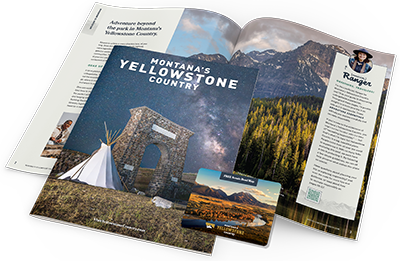Is the park open year-round?
Yes! Yellowstone is open in all four seasons, and each one has its own unique charm. From summer hikes to winter snowshoeing, there’s always something to explore.
When is the best time to visit?
There’s no bad time to visit Yellowstone! Want to snowmobile or ski? Winter’s your season. Dreaming of wildflowers and baby bison? Go for spring. Looking to fly-fish those world-famous rivers? Try summer or fall. Yellowstone is ready for you whenever you are. Find out more about Yellowstone’s seasons here.
How do I get into the park in winter?
Winter in Yellowstone is magical, but you’ll need to plan ahead. The only entrance open to personal vehicles this time of year is the North Entrance in Gardiner. From there, bundle up and hit the trails — or hop on a snowcoach tour or guided snowmobile tour from West Yellowstone.
Where can I stay in the park?
There are so many options for the perfect home base. Check out in-park lodging options, or explore gateway communities and cozy spots throughout the Yellowstone Country region here, no matter what kind of adventure you’re looking for.
Are there places to eat in the park?
There are multiple places to eat within the park. From casual grab-and-go spots to sit-down dining, Yellowstone’s got you covered. Options vary by season, so check what’s open during your visit. Whether it’s a hearty meal at a lodge or a picnic with a view, you won’t go hungry! Read more about dining in Yellowstone.
How many geysers are in the park?
Yellowstone is the geyser capital of the world. There are over 10,000 hydrothermal features here, including around 500 geysers — 300 of them are active. That’s more than half of all the world’s geysers!
When does Old Faithful erupt?
Old Faithful erupts roughly every 92 minutes, but it depends on the previous eruption’s duration. Check the prediction board at the visitor center for the latest schedule — it’s pretty accurate!
What’s this about a supervolcano? Should I be worried?
The Yellowstone Caldera is a massive volcanic feature and a dormant supervolcano. But there is no cause for concern — a "supereruption" isn’t predicted anytime soon. For now, enjoy the geothermal wonders it creates.
Can you swim in the park’s rivers, lakes or hot springs?
Swimming in most lakes and streams here isn’t a great idea — they’re icy cold year-round. If you’re determined to take a dip, Firehole Canyon near Madison Junction is popular in the summer. Soaking in hot springs inside the park, though? That’s a hard no — it’s dangerous and illegal. There are, however, hot springs located outside the park that are available for soaking. Explore Yellowstone Country’s hot springs.
Will I see a lot of wildlife in the park?
That depends on where you are, how long you’re here, what season it is, and what kind of mood the wildlife is in. Yellowstone is home to 67 species of mammals, 285 species of birds, and more, so your chances are pretty good. Early mornings and evenings tend to be the best times for sightings. And remember, always keep a safe distance—this isn’t a petting zoo!
Can I bring my pet into the park?
You can bring your dog, but it’ll limit what you can do. Pets must stay on a leash no longer than 6 feet, can’t be left unattended, and aren’t allowed on trails, boardwalks, or in the backcountry. They’re welcome near roads and parking areas within 100 feet, but Yellowstone is truly best explored without your furry friends.
How long does it take to drive the park loop?
The Grand Loop takes 4 to 7 hours to drive, depending on traffic, wildlife jams, and how many stops you make. Plan for a full day if you want to see the highlights at a relaxed pace.
Which park loop is better?
Both loops are incredible, but the stretch from Madison Junction to Old Faithful is a crowd favorite for its iconic geyser basins. You’ll see why once you’re there!
Do I need tickets to get into the park?
You’ll need an entrance pass, but no vehicle reservations are required. Save time by purchasing your pass online before arriving. If not, you can grab one at the entrance.
| Yellowstone National Park Entrance Fees |
| Private Non-commercial Vehicle |
$ 35.00 (valid for 7 days) |
| Motorcycle, Snowmobile |
$ 30.00 (valid for 7 days) |
| Single Entry (foot, bike, ski, 16+ years old) |
$ 20.00 (valid for 7 days) |
| Annual Pass (good 1 year from date of purchase) |
$ 70.00 (Yellowstone Annual Pass) |
Can I sleep in my car in the park?
Not in parking lots or on the roadside. However, if you’re staying at a reserved campsite, you can sleep in your car there. Otherwise, overnight stays are limited to those with lodging reservations.




